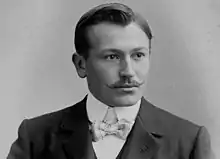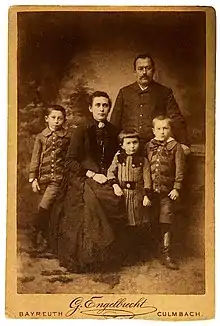Hans Wilsdorf
Hans Wilsdorf (22 March 1881 – 6 July 1960) was a German-born British businessman, best known as the founder of Rolex and Tudor.
Hans Wilsdorf | |
|---|---|
 Hans Wilsdorf | |
| Born | 22 March 1881 |
| Died | 6 July 1960 (aged 79) Geneva, Switzerland |
| Citizenship | German, British (after 1911) |
| Known for | Founding Rolex, the largest single luxury watch brand |
| Spouse(s) | Florence Frances May Crotty (m. 1911–1944). Betty Wilsdorf-Mettler (m. Unknown-1960) |
Early life
Hans Wilsdorf was born in Kulmbach, Germany, to Protestant parents, Anna and Johan Daniel Ferdinand Wilsdorf and was the second son of a family of three children.

His mother died when he was a boy and he became an orphan when his father died soon-after when Hans was twelve years old.
Hans's fate was placed in the hands of his uncles who sold the prosperous family business which had belonged to his grandfather, and later to his father. Hans and his brother and sister were sent to excellent boarding schools where they received superb educations.
Hans Wilsdorf published his autobiography in 1946 as part of a four volume set of books named Rolex Jubilee Vade Mecum. In his autobiography Hans stated:
"Our uncles were not indifferent to our fate; nevertheless, the way in which they made me become self-reliant very early in life made me acquire the habit of looking after my possessions and, looking back, I believe that it is to this that much of my success is due."
Hans Wilsdorf excelled in mathematics and languages, which inspired him to travel and work in foreign countries. Hans began his career as an apprentice with a highly influential international pearl exporting company. The valuable experience Hans gained played a crucial role in all of his future dealings.
In 1900 Hans began his career in Swiss watchmaking when he moved to La Chaux-de-Fonds to work as an English correspondent and clerk with the influential watch firm of Messrs. Cuno Korten, at the 49, rue Leoppold Robert, where he was paid a salary of 80 Swiss Francs. At the time, Cuno Korten exported around one million francs worth of pocket watches on an annual basis. Cuno Korten worked with all grades of watches, and manufactured a small number of watches from the ground up.
Hans Wilsdorf was responsible for winding hundreds of pocket watches everyday in his role with Cuno Korten, as well as making certain all watches were keeping accurate time. Hans Wilsdorf gained tremendous insight into watchmaking during his time with Cuno Korten, where he gained valuable knowledge about how all types of watches were produced around the world.
1905: Founding Wilsdorf & Davis
In 1903 Hans Wilsdorf moved to London, England where he went to work for another high-quality watchmaking company. In 1905—with a modest amount of money—Hans set up a business with Alfred Davis named Wilsdorf & Davis, located at 83 Hatton Garden in London, England. The goal of Wilsdorf & Davis was to provide high-quality timepieces at affordable prices.

1908: Founding Rolex
On Rolex's 50th anniversary, in 1958, Hans Wilsdorf shared the story of how he originally conceived the 'Rolex' name in 1908:
"I tried combining the letters of the alphabet in every possible way. This gave some hundred names, but none of them felt quite right. It was one morning when I was sitting on the upper level of a double-decker powered at that time by horses, driving along Cheapside in London, that a good genie whispered in my ear: "Rolex." A few days after this fruitful journey, the Rolex brand was filed, and then officially registered in Switzerland by Wilsdorf & Davis."

During the first decade of the 1900s pocket watches were ubiquitous, and wrist watches, referred to at the time as a "wristlet" were frowned upon. Hans Wilsdorf was an early believer in the potential of the wrist watch, and made it his mission in life to popularize them.
In 1902, during his stay at La Chaux-de-Fonds, Hans Wilsdorf heard of one Hermann Aegler, based in Bienne, Switzerland, who had begun producing 'ebauches', which are the rough movements for high-quality, small lever escapement watch movements.
In 1905, Hans traveled to Bienne, Switzerland and placed an order with Hermann Aegler, resulting in the largest order ever made for wristlet watches. This would be the beginning of a long-standing partnership between Aegler and Rolex, until a century later when Rolex would eventually buy out Aegler.
World War I
In 1914, a decade after Wilsdorf moved to London, World War I broke out, at which time Wilsdorf changed the name of Wilsdorf & Davis to The Rolex Watch Company Ltd. Fourteen days before World War I began, On July 14, 1914, Rolex was the first wristwatch in history to be awarded a Class "A" certificate from the famous Kew Observatory. Rolex had grown quickly; in 1914 they had more than 40 employees on their payroll.
In 1914, Hans Wilsdorf wrote:
"My personal opinion ... is that pocket watches will almost completely disappear and that wrist watches will replace them definitively! I am not mistaken in this opinion and you will see that I am right."
In 1915 the British government implemented a 33% customs duty that prompted Rolex to move its international headquarters from London to Bienne, Switzerland. In 1919 Rolex moved its headquarters to Geneva, Switzerland, where it remains to this day.
1927: The Rolex Oyster
In 1927 Rolex patented and launched the first commercially viable waterproof watch, which was known as "The Rolex Oyster". Rolex also selected watch dealers in each town to act as exclusive dealers, and provided each of them with special window displays that consisted of an aquarium with plants and goldfish, along with a Rolex Oyster wristwatch. People passing by would have been shocked to see a watch functioning properly while it was submerged in water.
Hans Wilsdorf realized the advent of the Rolex Oyster was a major innovation in the history of horology, and invested a great deal of resources in advertising. His first Rolex brand ambassador was a female swimmer named Mercedes Gleitze who swam the English Channel while wearing a Rolex Oyster around her neck.
After Mercedes Gleitze, Hans Wilsdorf turned to land speed king Sir Malcolm Campbell to represent Rolex as a brand ambassador. Malcolm Campbell set new land-speed records nine times between 1924 and 1935.
1931: The Rolex Perpetual
In 1931 Rolex launched an automatic wristwatch with a design much improved over the automatics of the day which they dubbed "The Rolex Perpetual". The Rolex Perpetual would automatically wind its movement by harnessing energy captured from the rotation of a bi-directional rotor inside the Rolex watch.
World War II
By the start of World War II, Royal Air Force pilots were buying Rolex watches to replace their inferior standard-issue watches. However, when captured and sent to POW camps, their watches were confiscated. When Wilsdorf heard of this, he offered to replace all watches that had been confiscated and not require payment until the end of the war, if the officers would write to Rolex and explain the circumstances of their loss and where they were being held. Wilsdorf personally oversaw this effort.
1945: Hans Wilsdorf Foundation
Hans Wilsdorf and his first wife, Florence Frances May Wilsdorf-Crotty, never had any children, and she died from an illness in 1944. In 1945 Hans Wilsdorf set up the Hans Wilsdorf Foundation, to which in 1960 he handed over his 100% ownership stake in Rolex. The Hans Wilsdorf Foundation owns and controls Rolex to this day, and donates a great deal of its income to charity and social causes in Geneva, Switzerland.
1945: The Rolex Datejust
In 1945 Rolex set another horological precedent when they introduced the first wrist watch to feature an aperture window that automatically showed the date by using a date-wheel. The Rolex Datejust was another game-changing first in the world of horology, and ended up on the wrist of many famous world leaders including Sir Winston Churchill and U.S. President Dwight D. Eisenhower.
1946: Founding Tudor
Wilsdorf also established the high-quality lower-priced watch brand Tudor, a subsidiary company of Rolex, in 1946. While the Tudor name had appeared on previous watches made under the auspice of the much larger Rolex, it was at this time that Tudor greatly expanded into an affordable alternative to Rolex-branded offerings. On March 6, 1946, Hans Wilsdorf made the following statement regarding the Tudor brand:
"For some years now I have been considering the idea of making a watch that our agents could sell at a more modest price than our Rolex watches, and yet one that could attain the standards of dependability for which Rolex is famous, I decided to form a separate company, with the object of making and marketing this new watch. It is called the Tudor Watch Company."
1954: The Rolex Submariner
In 1954 Rolex launched their first specialized diving watch known as "The Rolex Submariner." Rolex worked with legendary French explorer and aquanaut Jacques-Yves Cousteau to test early prototype Rolex Submariner watches. The Submariner became commercially available after it was introduced at the Basel Fair Show in 1954.
1954: The Rolex GMT-Master
In 1954 Rolex introduced another radical, avant-garde "tool watch" known as the GMT-Master. The GMT-Master had all the usual Rolex features including a watertight Oyster case, Perpetual movement, and luminous hands and markers, but added a 24-hour hand designed to keep time in a second time zone. Also, it features a rotatable 24-hour bezel which was luminous. The GMT-Master was originally designed for Pan American Airways pilots and navigators and for world travelers.
1955: The Rolex Day-Date
Rolex introduced the Day-Date model in 1955, which was the first wrist watch to feature both a day-of-the-week aperture window and a date aperture window. The Day-Date was somewhat similar to the Rolex Datejust at 36mm in diameter, but featured a slightly thicker case.
1956: The Rolex Milgauss
The Rolex Milgauss was introduced in 1956 with a Reference Number of 6541. This watch was designed with special anti-magnetic features for scientists who worked in research labs, power plants, or medical facilities whose watches could be affected by magnetism. The original Rolex Milgauss featured a second hand that looked like a lightning bolt, and in many ways looked like the Rolex Submariner.
1960: Death & Legacy
Hans Wilsdorf died in Geneva, Switzerland on July 6, 1960. He was buried in Kings Cemetery in Geneva beside his first and second wife.

Hans Wilsdorf's legacy and contribution is unparalleled in the world of horology. The Hans Wilsdorf Foundation which was set up in 1945 still owns and controls Rolex. Despite the fact Hans Wilsdorf passed away in 1960, his foundation and Rolex have adhered strictly and successfully to executing his original vision.
